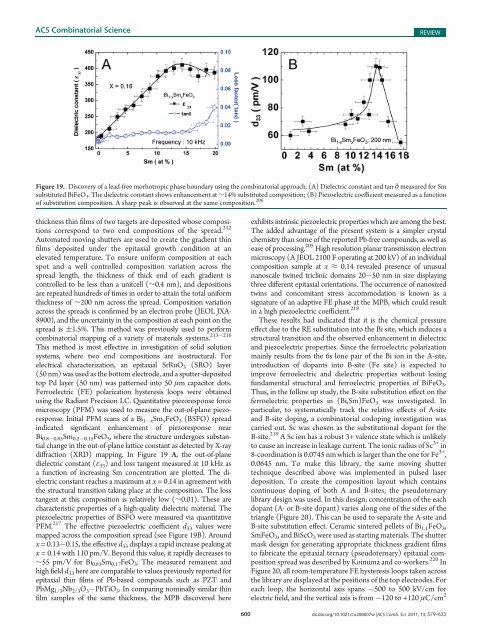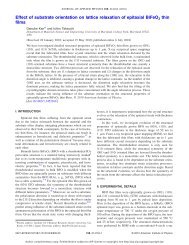Combinatorial and High-Throughput Screening of Materials ...
Combinatorial and High-Throughput Screening of Materials ...
Combinatorial and High-Throughput Screening of Materials ...
You also want an ePaper? Increase the reach of your titles
YUMPU automatically turns print PDFs into web optimized ePapers that Google loves.
ACS <strong>Combinatorial</strong> Science<br />
REVIEW<br />
Figure 19. Discovery <strong>of</strong> a lead-free morhotropic phase boundary using the combinatorial approach. (A) Dielectric constant <strong>and</strong> tan δ measured for Sm<br />
substituted BiFeO 3 . The dielectric constant shows enhancement at ∼14% substituted composition; (B) Piezoelectric coefficient measured as a function<br />
<strong>of</strong> substitution composition. A sharp peak is observed at the same composition. 206<br />
thickness thin films <strong>of</strong> two targets are deposited whose compositions<br />
correspond to two end compositions <strong>of</strong> the spread. 212<br />
Automated moving shutters are used to create the gradient thin<br />
films deposited under the epitaxial growth condition at an<br />
elevated temperature. To ensure uniform composition at each<br />
spot <strong>and</strong> a well controlled composition variation across the<br />
spread length, the thickness <strong>of</strong> thick end <strong>of</strong> each gradient is<br />
controlled to be less than a unitcell (∼0.4 nm), <strong>and</strong> depositions<br />
are repeated hundreds <strong>of</strong> times in order to attain the total uniform<br />
thickness <strong>of</strong> ∼200 nm across the spread. Composition variation<br />
across the spreads is confirmed by an electron probe (JEOL JXA-<br />
8900), <strong>and</strong> the uncertainty in the composition at each point on the<br />
spread is (1.5%. This method was previously used to perform<br />
213 216<br />
combinatorial mapping <strong>of</strong> a variety <strong>of</strong> materials systems.<br />
This method is most effective in investigation <strong>of</strong> solid solution<br />
systems, where two end compositions are isostructural. For<br />
electrical characterization, an epitaxial SrRuO 3 (SRO) layer<br />
(50 nm) was used as the bottom electrode, <strong>and</strong> a sputter-deposited<br />
top Pd layer (50 nm) was patterned into 50 μm capacitor dots.<br />
Ferroelectric (FE) polarization hysteresis loops were obtained<br />
using the Radiant Precision LC. Quantitative piezoresponse force<br />
microscopy (PFM) was used to measure the out-<strong>of</strong>-plane piezoresponse.<br />
Initial PFM scans <strong>of</strong> a Bi 1 x Sm x FeO 3 (BSFO) spread<br />
indicated significant enhancement <strong>of</strong> piezoresponse near<br />
Bi 0.8 0.85 Sm 0.2 0.15 FeO 3 , where the structure undergoes substantial<br />
change in the out-<strong>of</strong>-plane lattice constant as detected by X-ray<br />
diffraction (XRD) mapping. In Figure 19 A, the out-<strong>of</strong>-plane<br />
dielectric constant (ε 33 ) <strong>and</strong> loss tangent measured at 10 kHz as<br />
a function <strong>of</strong> increasing Sm concentration are plotted. The dielectric<br />
constant reaches a maximum at x = 0.14 in agreement with<br />
the structural transition taking place at the composition. The loss<br />
tangent at this composition is relatively low (∼0.01). These are<br />
characteristic properties <strong>of</strong> a high-quality dielectric material. The<br />
piezoelectric properties <strong>of</strong> BSFO were measured via quantitative<br />
PFM. 217 The effective piezoelectric coefficient d 33 values were<br />
mapped across the composition spread (see Figure 19B). Around<br />
x = 0.13 0.15, the effective d 33 displays a rapid increase peaking at<br />
x = 0.14 with 110 pm/V. Beyond this value, it rapidly decreases to<br />
∼55 pm/V for Bi 0.83 Sm 0.17 FeO 3 . The measured remanent <strong>and</strong><br />
high field d 33 here are comparable to values previously reported for<br />
epitaxial thin films <strong>of</strong> Pb-based compounds such as PZT <strong>and</strong><br />
PbMg 1/3 Nb 2/3 O 3 PbTiO 3 . In comparing nominally similar thin<br />
film samples <strong>of</strong> the same thickness, the MPB discovered here<br />
exhibits intrinsic piezoelectric properties which are among the best.<br />
The added advantage <strong>of</strong> the present system is a simpler crystal<br />
chemistry than some <strong>of</strong> the reported Pb-free compounds, as well as<br />
ease <strong>of</strong> processing. 205 <strong>High</strong> resolution planar transmission electron<br />
microscopy (A JEOL 2100 F operating at 200 kV) <strong>of</strong> an individual<br />
composition sample at x ≈ 0.14 revealed presence <strong>of</strong> unusual<br />
nanoscale twined triclinic domains 20 50 nm in size displaying<br />
three different epitaxial orientations. The occurrence <strong>of</strong> nanosized<br />
twins <strong>and</strong> concomitant stress accommodation is known as a<br />
signature <strong>of</strong> an adaptive FE phase at the MPB, which could result<br />
in a high piezoelectric coefficient. 218<br />
These results had indicated that it is the chemical pressure<br />
effect due to the RE substitution into the Bi site, which induces a<br />
structural transition <strong>and</strong> the observed enhancement in dielectric<br />
<strong>and</strong> piezoelectric properties. Since the ferroelectric polarization<br />
mainly results from the 6s lone pair <strong>of</strong> the Bi ion in the A-site,<br />
introduction <strong>of</strong> dopants into B-site (Fe site) is expected to<br />
improve ferroelectric <strong>and</strong> dielectric properties without losing<br />
fundamental structural <strong>and</strong> ferroelectric properties <strong>of</strong> BiFeO 3 .<br />
Thus, in the follow up study, the B-site substitution effect on the<br />
ferroelectric properties in (Bi,Sm)FeO 3 was investigated. In<br />
particular, to systematically track the relative effects <strong>of</strong> A-site<br />
<strong>and</strong> B-site doping, a combinatorial codoping investigation was<br />
carried out. Sc was chosen as the substitutional dopant for the<br />
B-site. 219 A Sc ion has a robust 3+ valence state which is unlikely<br />
to cause an increase in leakage current. The ionic radius <strong>of</strong> Sc 3+ in<br />
8-coordination is 0.0745 nm which is larger than the one for Fe 3+ ,<br />
0.0645 nm. To make this library, the same moving shutter<br />
technique described above was implemented in pulsed laser<br />
deposition. To create the composition layout which contains<br />
continuous doping <strong>of</strong> both A <strong>and</strong> B-sites, the pseudoternary<br />
library design was used. In this design, concentration <strong>of</strong> the each<br />
dopant (A- or B-site dopant) varies along one <strong>of</strong> the sides <strong>of</strong> the<br />
triangle (Figure 20). This can be used to separate the A-site <strong>and</strong><br />
B-site substitution effect. Ceramic sintered pellets <strong>of</strong> Bi 1.1 FeO 3 ,<br />
SmFeO 3 , <strong>and</strong> BiScO 3 were used as starting materials. The shutter<br />
mask design for generating appropriate thickness gradient films<br />
to fabricate the epitaxial ternary (pseudoternary) epitaxial composition<br />
spread was described by Koinuma <strong>and</strong> co-workers. 220 In<br />
Figure 20, all room-temperature FE hysteresis loops taken across<br />
the library are displayed at the positions <strong>of</strong> the top electrodes. For<br />
each loop, the horizontal axis spans 500 to 500 kV/cm for<br />
electric field, <strong>and</strong> the vertical axis is from 120 to +120 μC/cm 2<br />
600 dx.doi.org/10.1021/co200007w |ACS Comb. Sci. 2011, 13, 579–633












